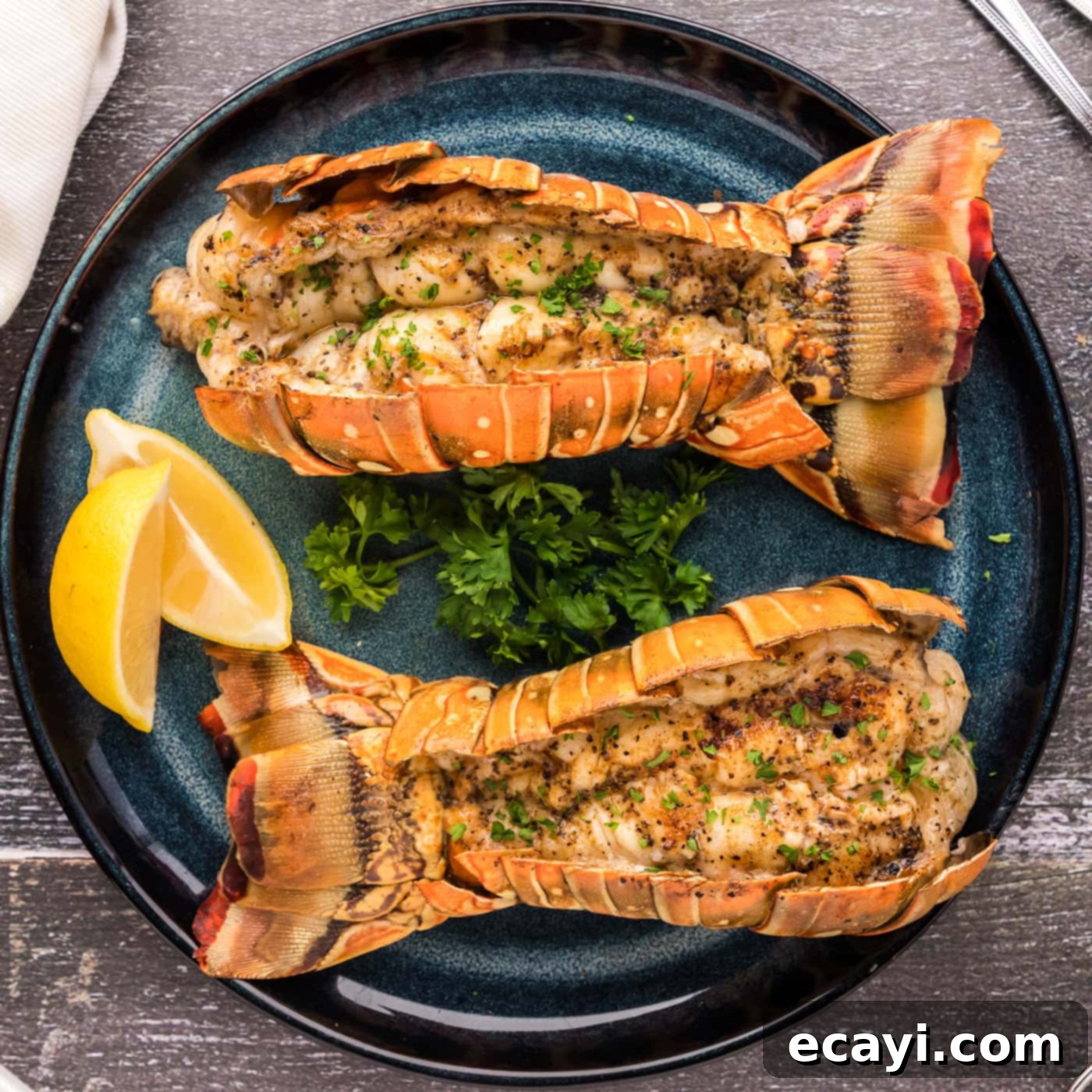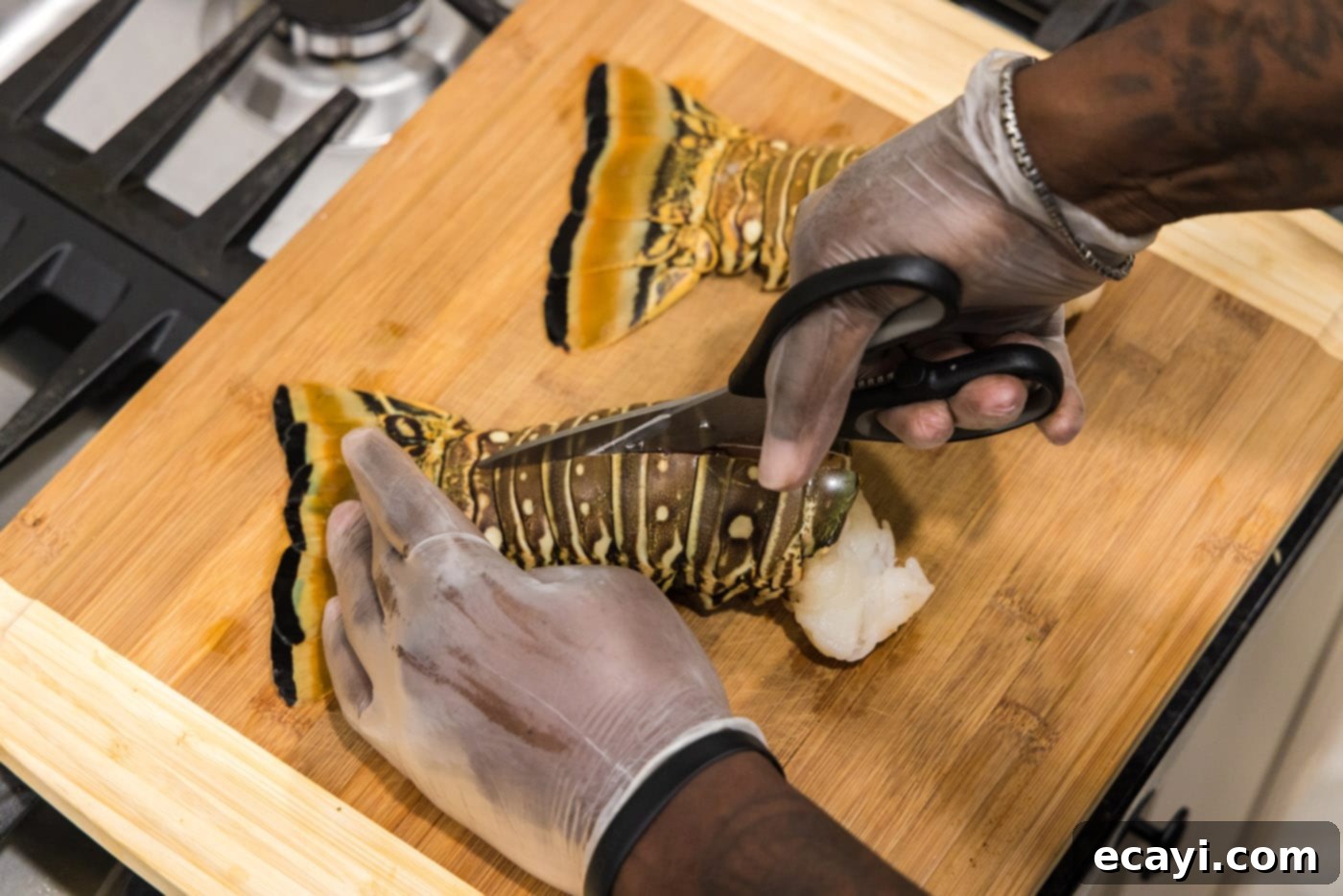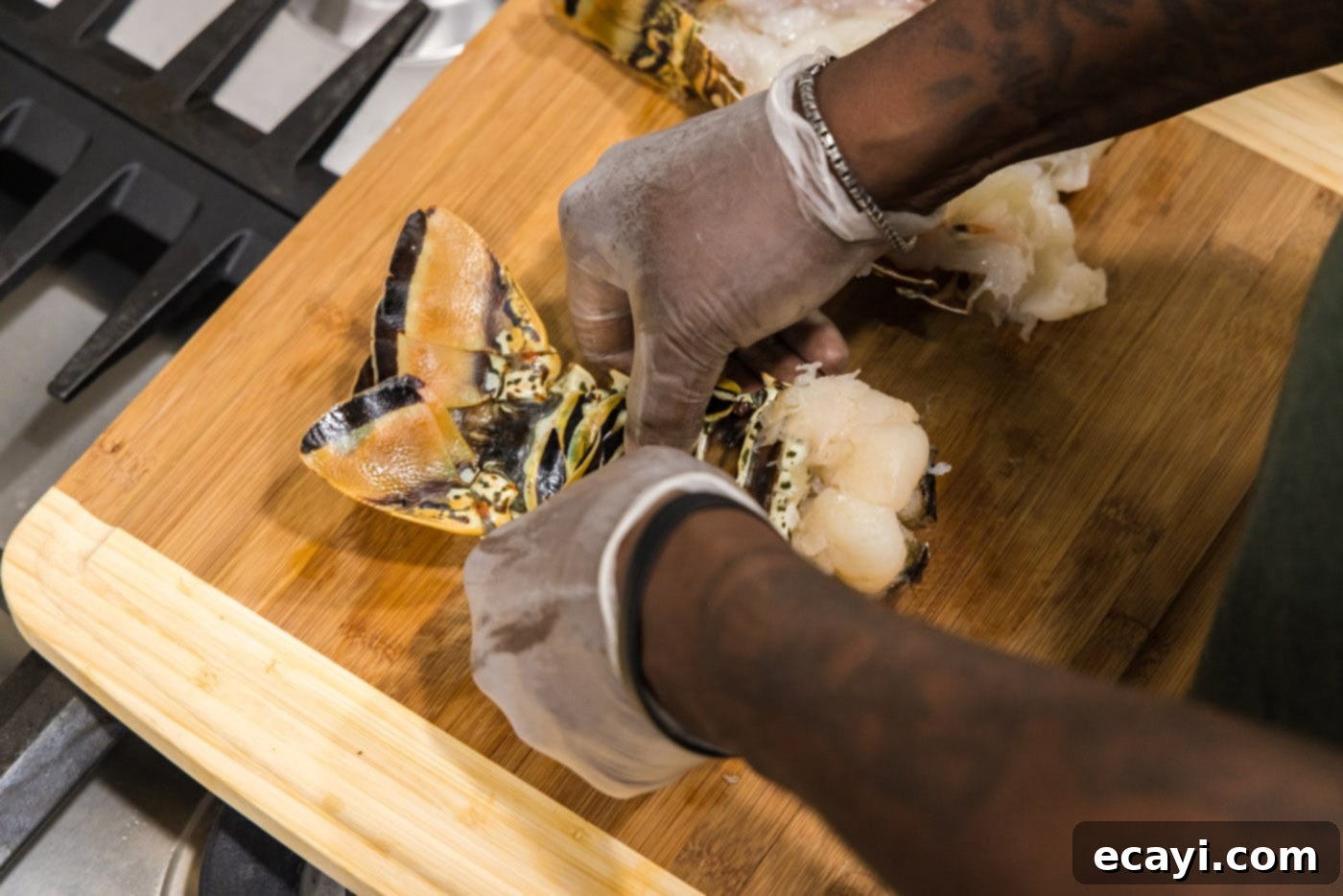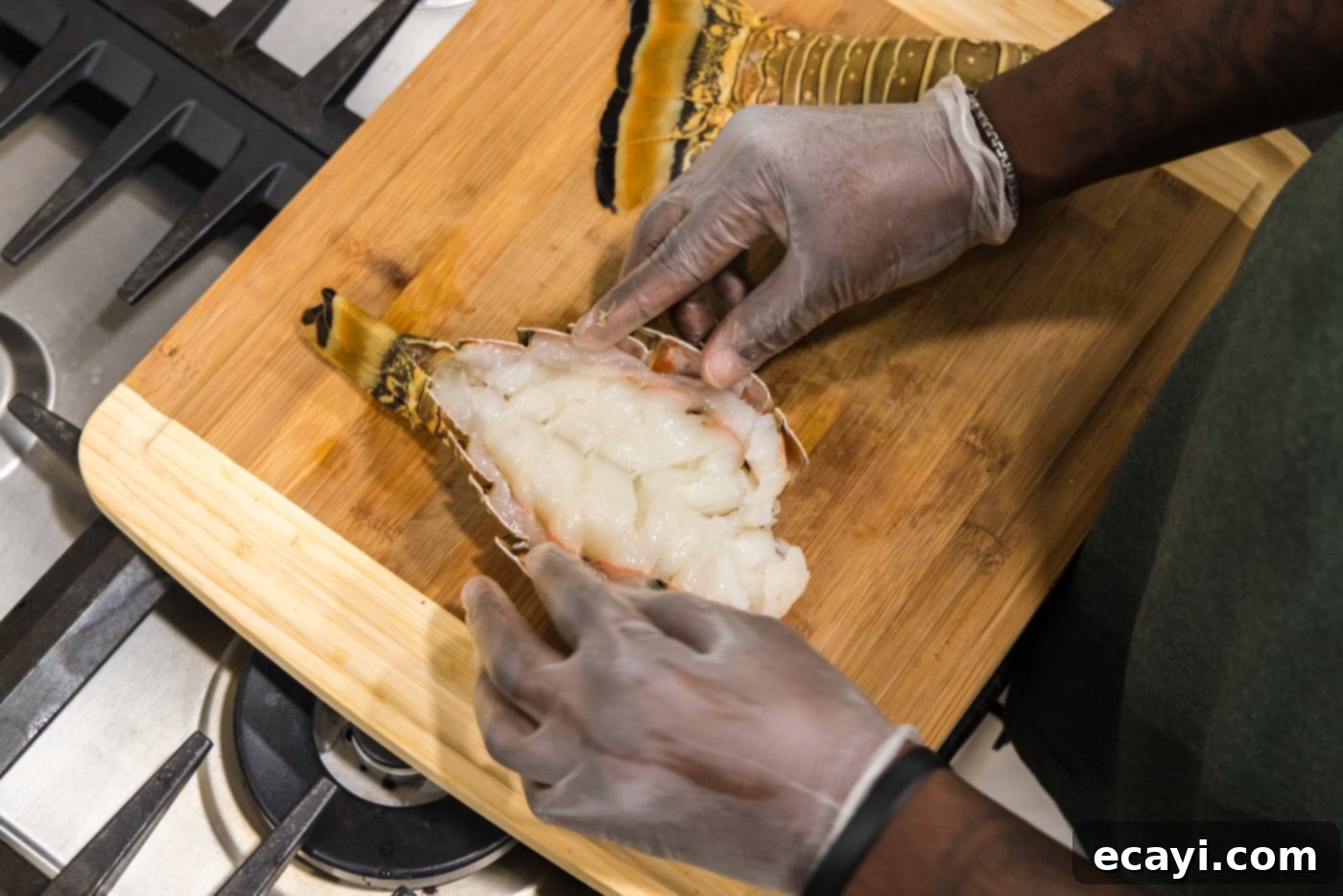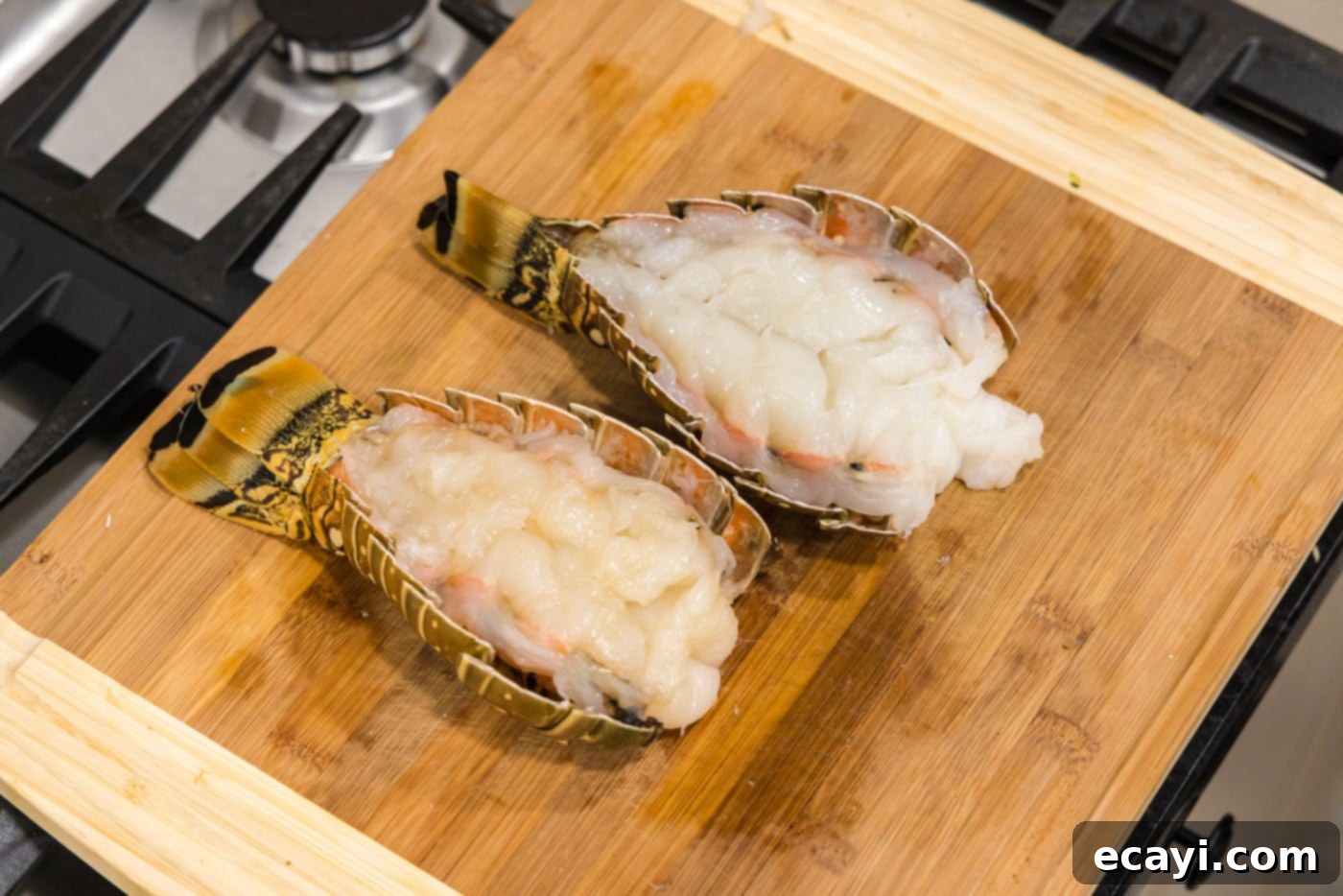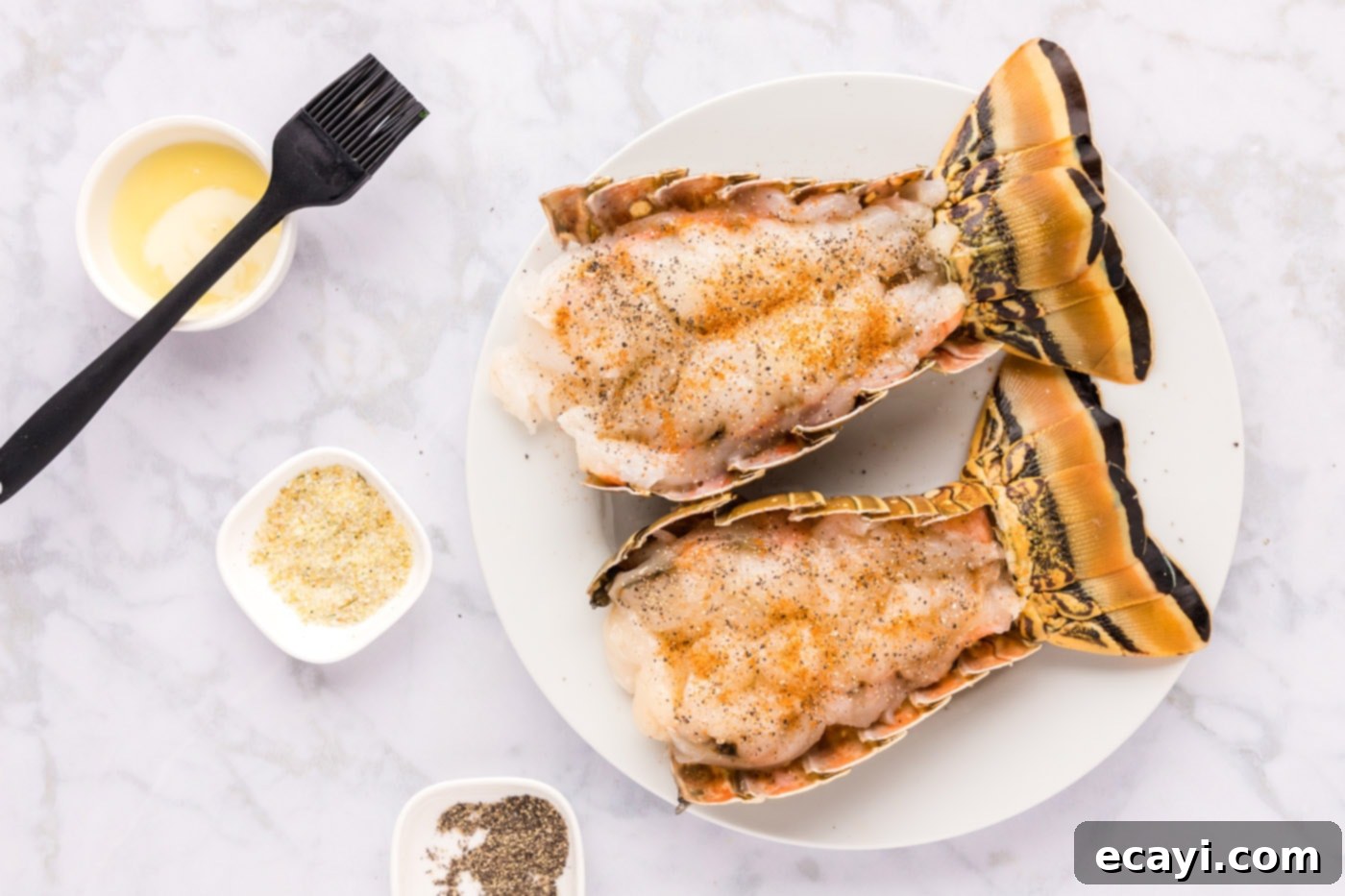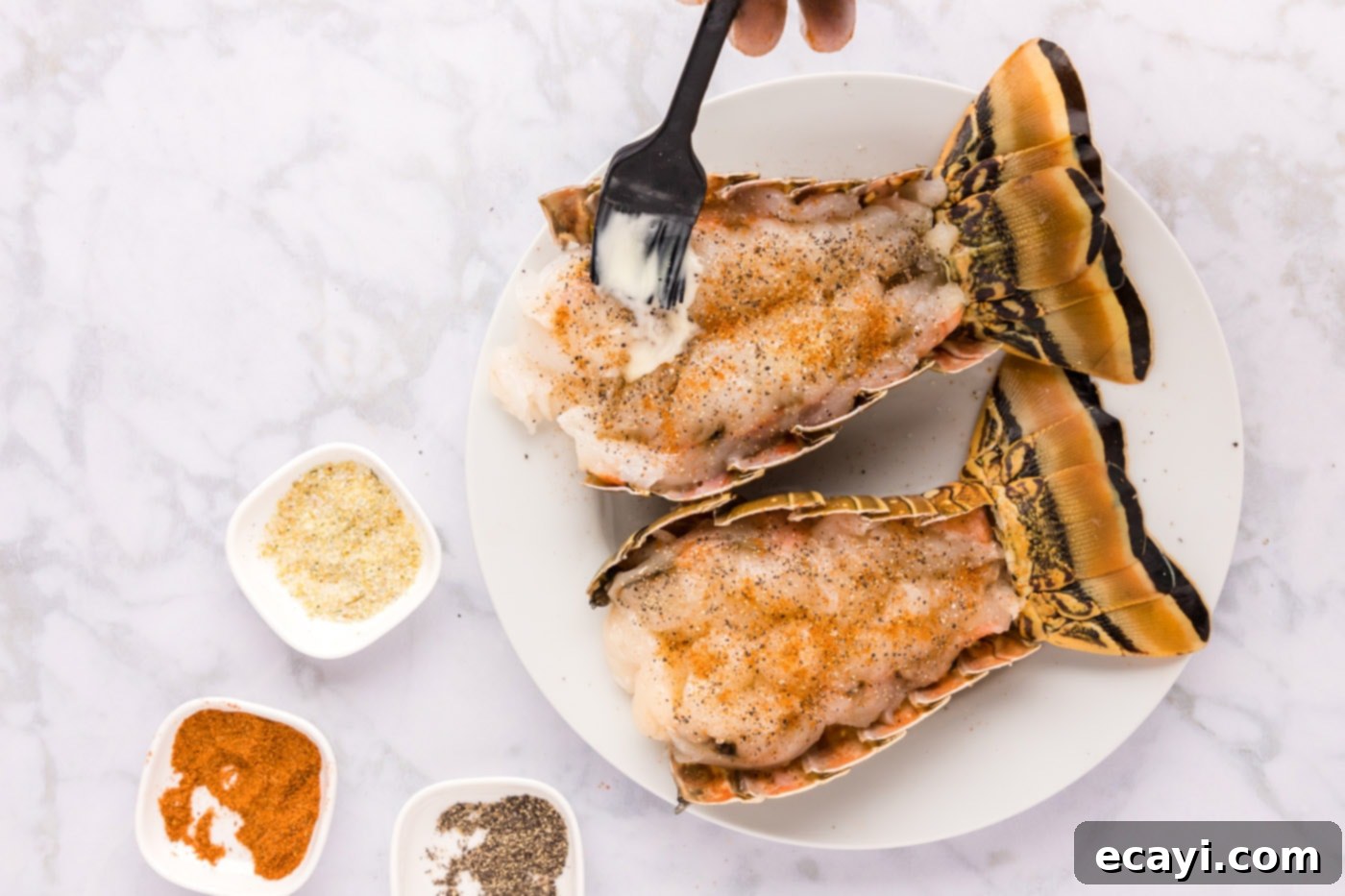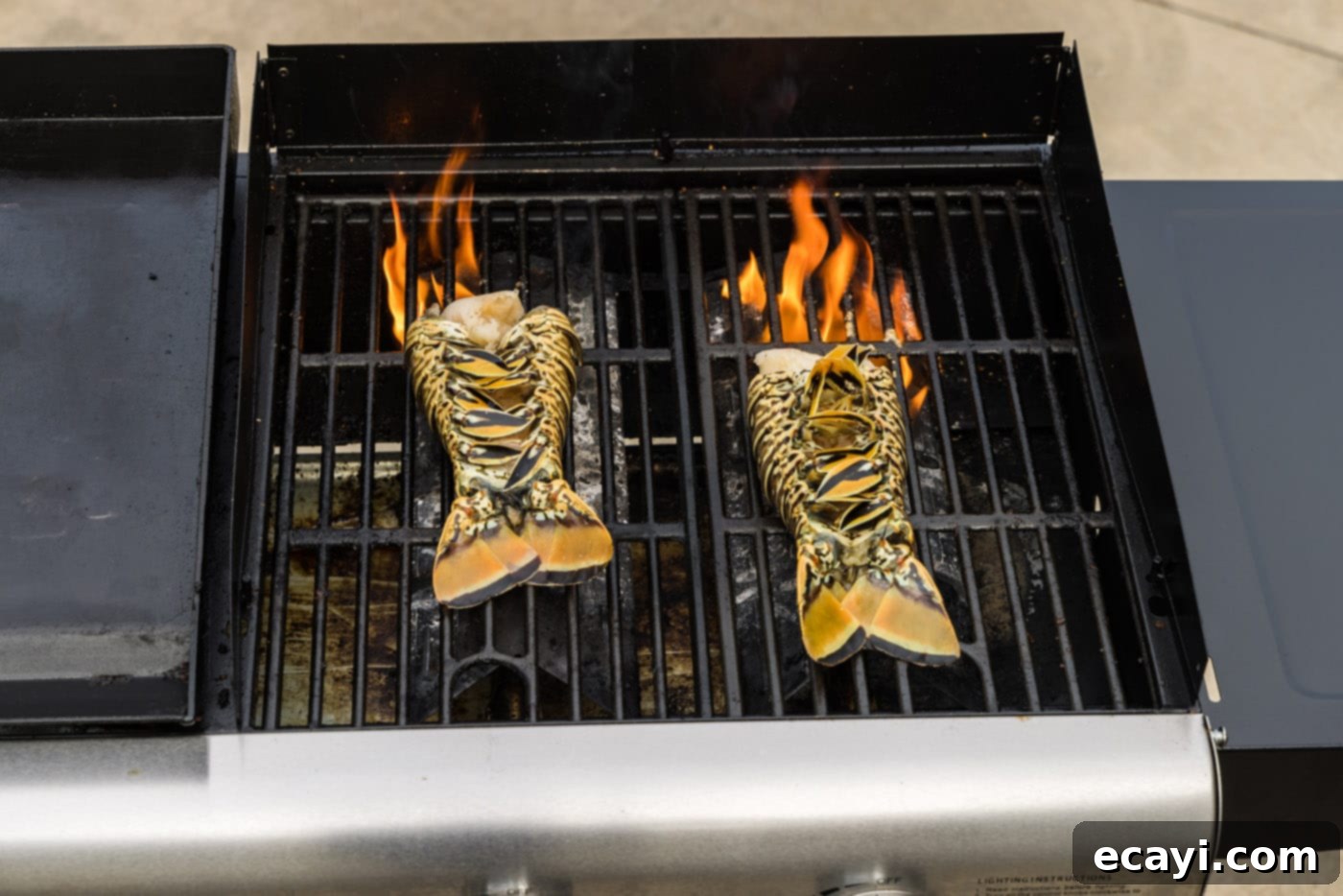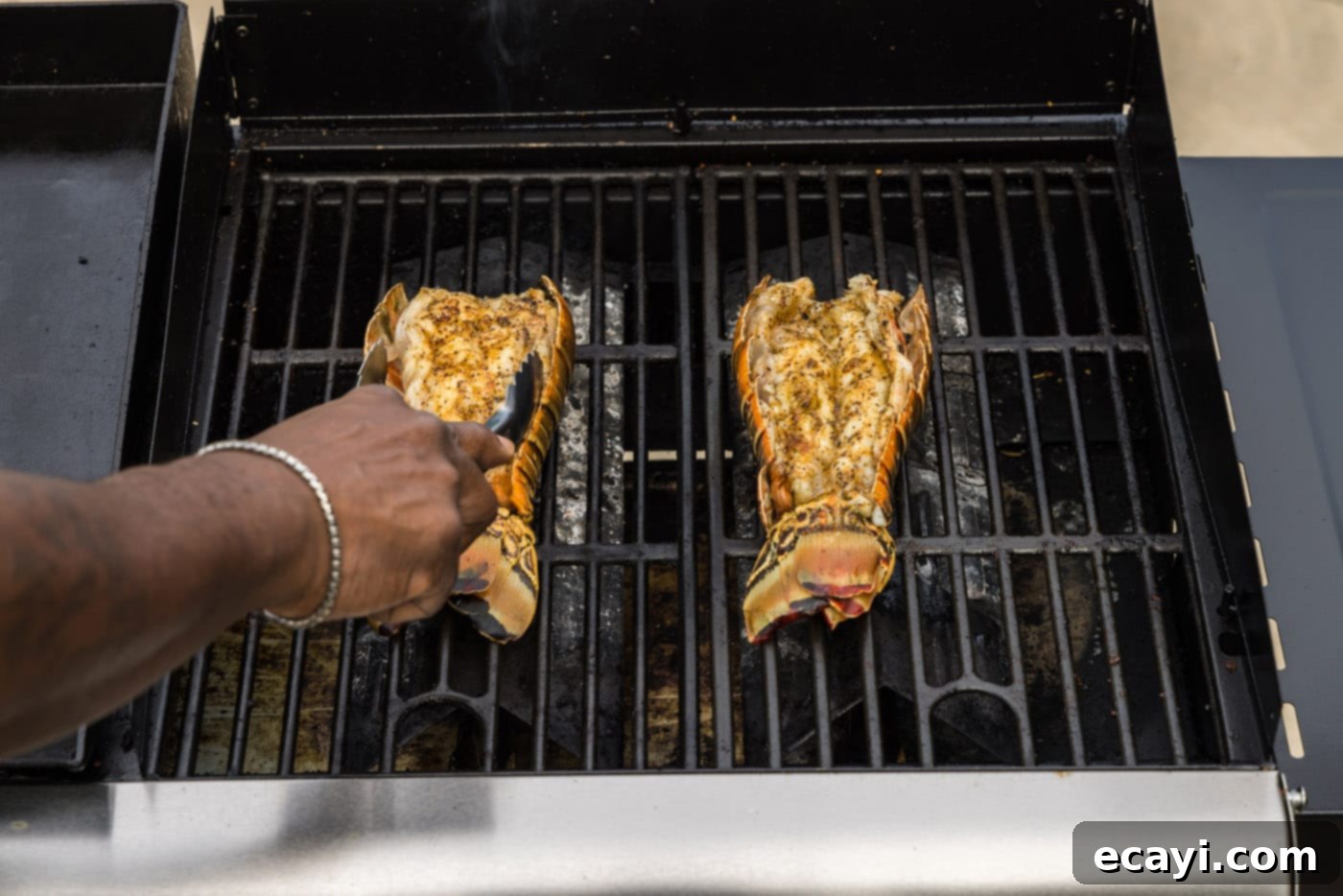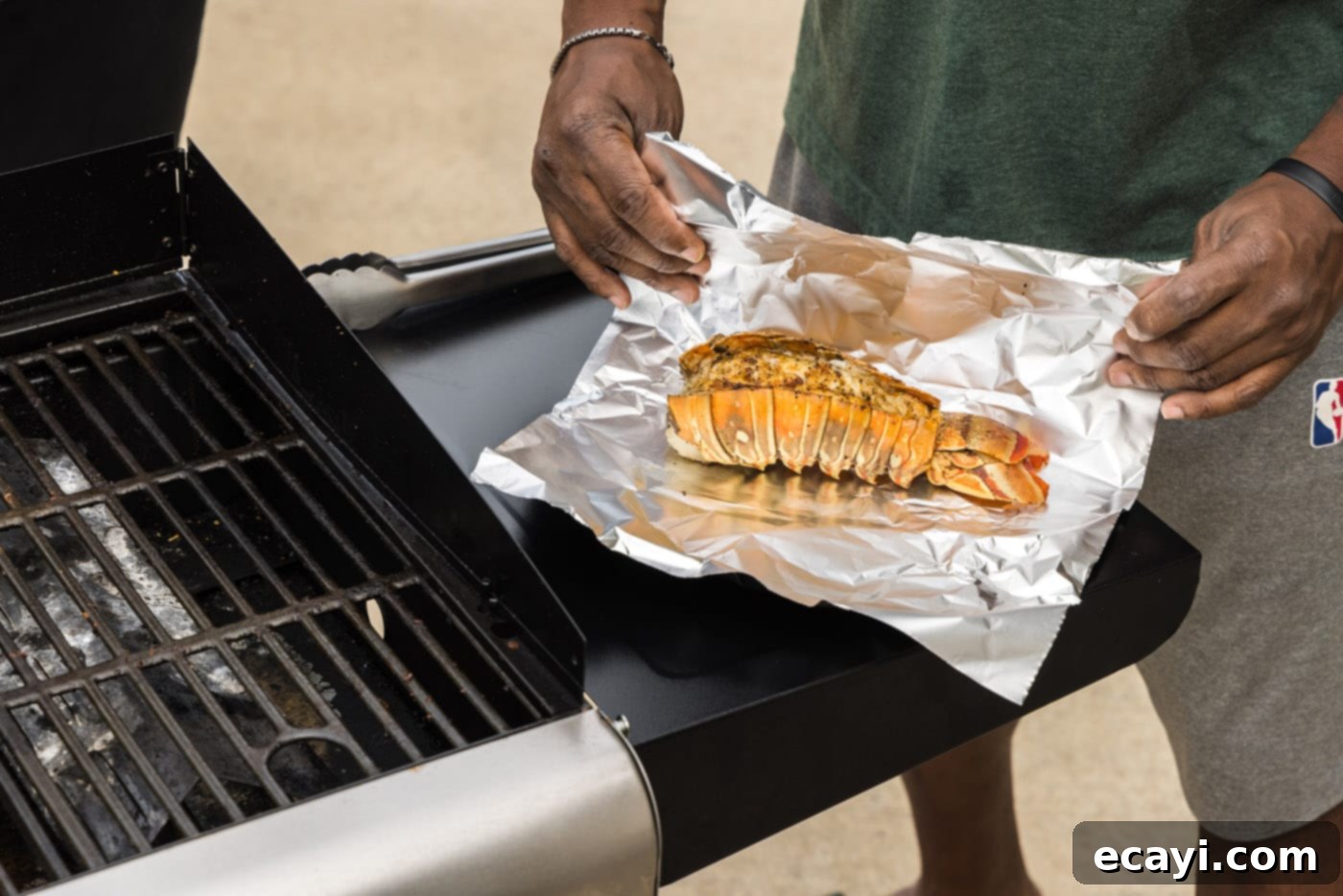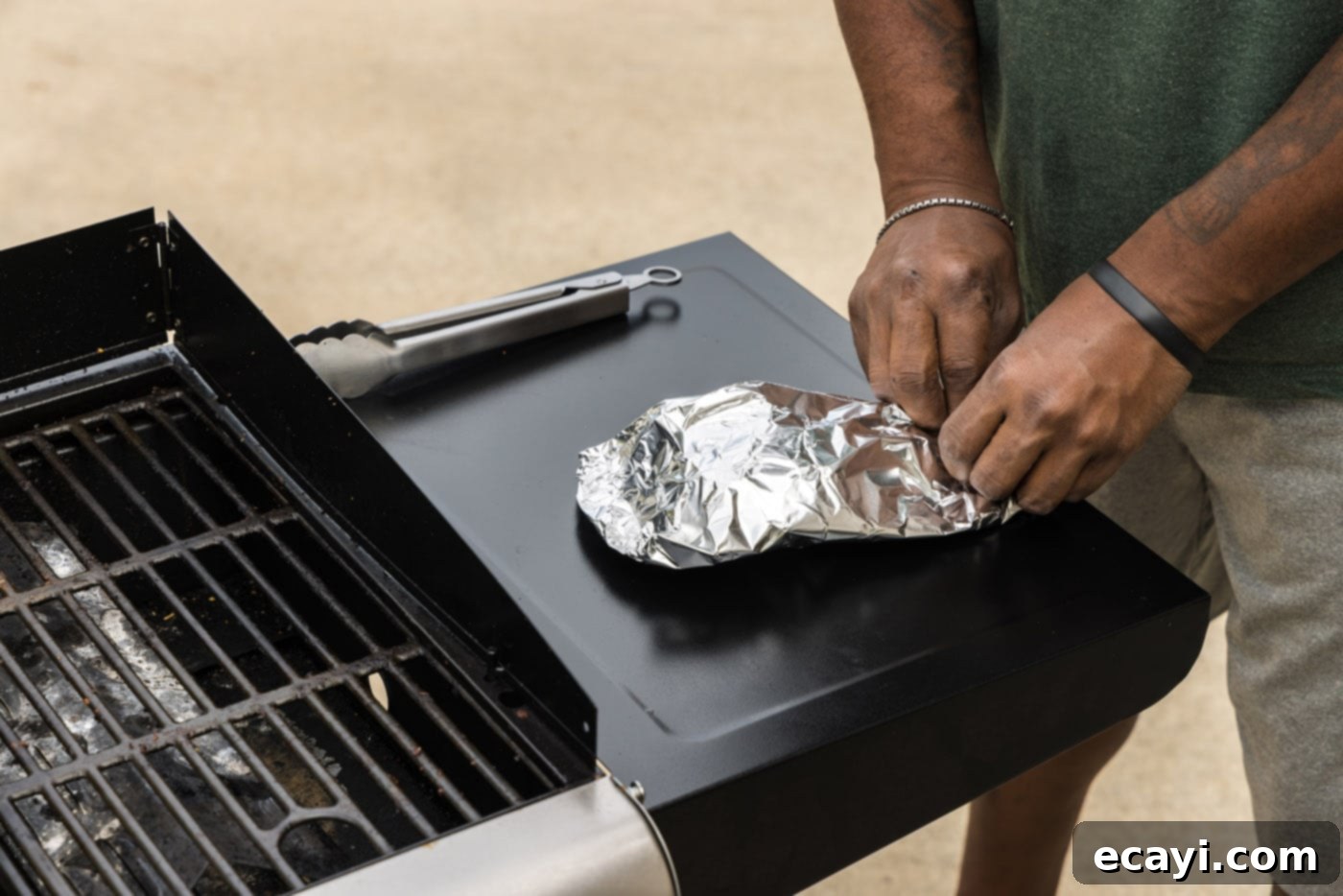How to Grill Perfect Lobster Tails: A Succulent, Restaurant-Quality Recipe at Home
Prepare to impress with this incredibly simple yet extraordinarily elegant grilled lobster tail recipe. In just about 25 minutes, with only a handful of staple ingredients, you can transform fresh or frozen lobster tails into a tender, succulent, and beautifully seared culinary masterpiece. Say goodbye to guesswork and hello to golden-crusted lobster tails, perfectly cooked on your grill, ready to grace any dinner table or special occasion.
Grilling lobster tails infuses them with a unique smoky flavor while butter and seasonings ensure they remain moist and tender. This guide will walk you through every step, from selecting the best lobster tails to expert grilling techniques, ensuring you achieve a restaurant-quality dish right in your backyard. Get ready to savor every exquisite bite of this luxurious seafood.
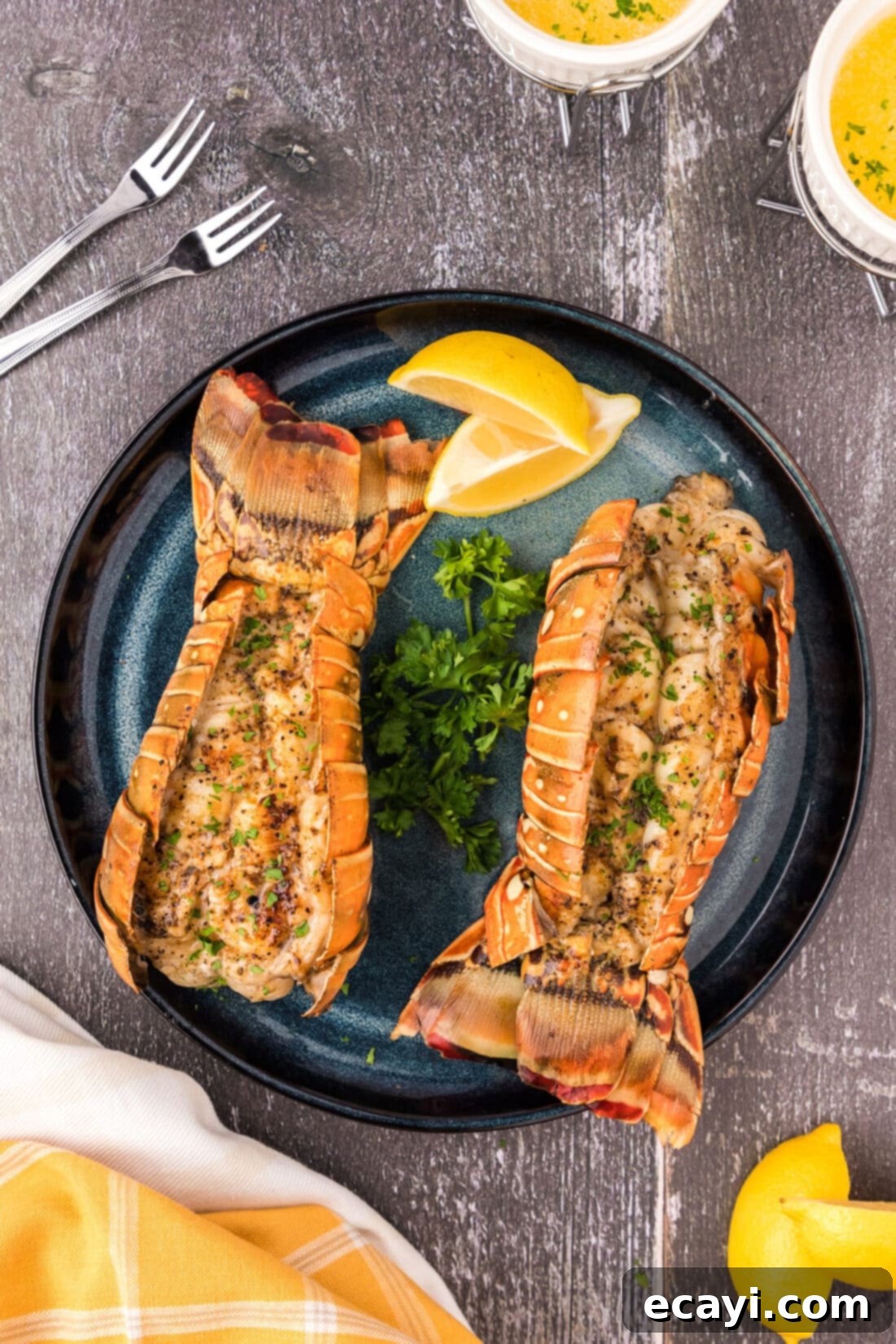
Why This Grilled Lobster Tail Recipe is a Must-Try
There’s an undeniable allure to lobster, often perceived as a delicacy reserved for fancy restaurants. However, this grilled lobster tail recipe shatters that notion by making gourmet dining accessible and surprisingly simple at home. What makes this recipe truly stand out is its perfect blend of simplicity, speed, and sensational flavor. It’s designed to deliver tender, juicy lobster with a delightful char, thanks to the magic of the grill.
The secret to its success lies in minimal yet impactful seasoning. A combination of freshly ground black pepper, savory garlic salt, and the classic, robust flavor of Old Bay seasoning creates a taste profile that enhances the natural sweetness of the lobster without overpowering it. Brushed generously with softened butter, these lobster tails cook up tender and succulent, boasting a beautiful golden crust that’s incredibly appealing.
This recipe is also incredibly versatile. It serves two generously, making it ideal for a romantic dinner or a small celebration. But don’t let that limit you! You can effortlessly double or even triple the recipe to cater to more guests. And if you happen to have any leftover tails – a rare occurrence, we admit – they can be transformed into another exquisite meal, like a rich lobster bisque, ensuring no delicious morsel goes to waste. It’s a dish that not only satisfies your palate but also leaves you feeling like a seasoned chef.
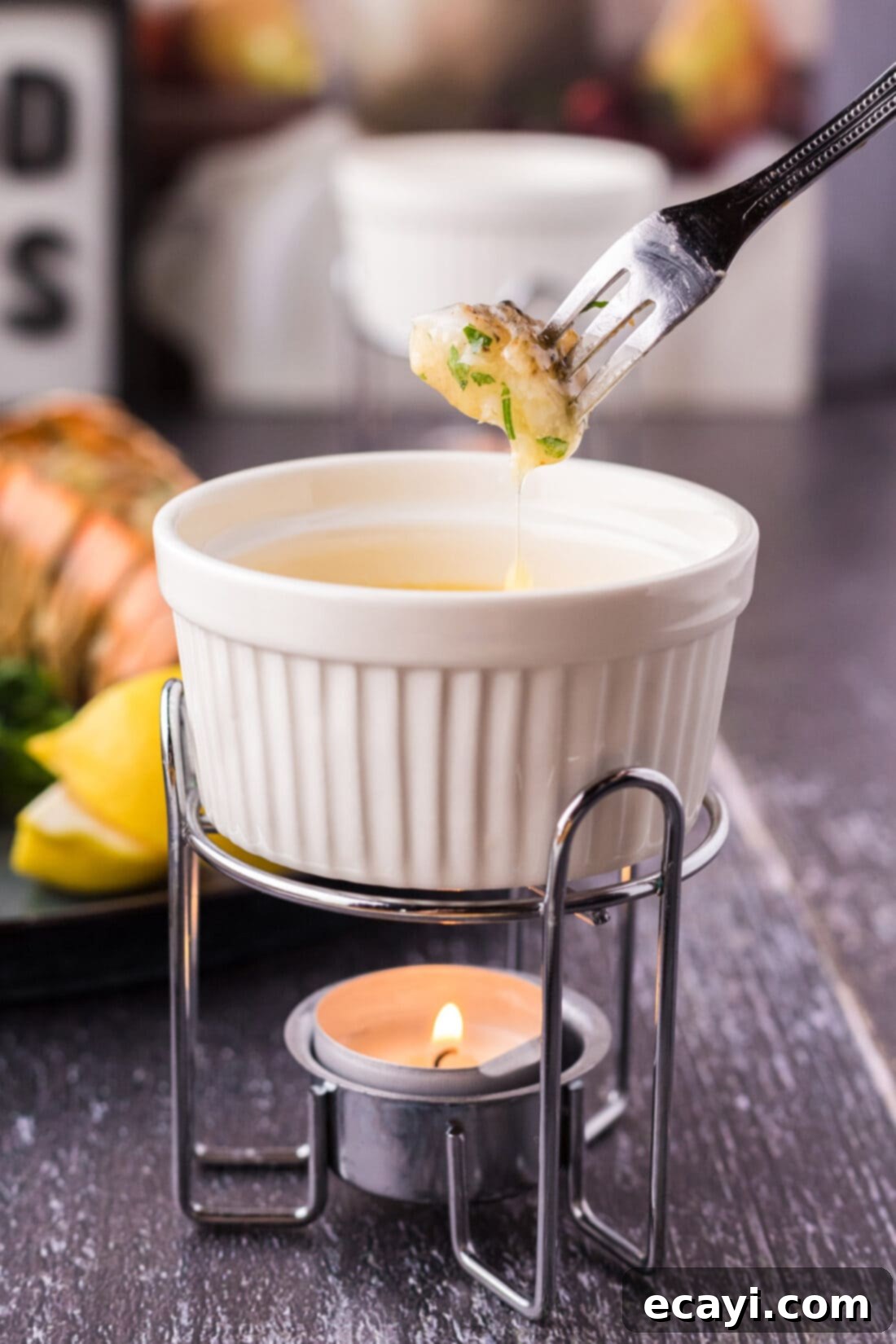
Essential Ingredients for Perfect Grilled Lobster Tails
Achieving perfectly grilled lobster tails doesn’t require a long list of exotic ingredients. This recipe focuses on enhancing the natural flavors of the lobster with just a few key components. You can find all specific measurements and detailed instructions in the printable recipe card towards the end of this post, but here’s a closer look at what you’ll need and why each element is important:
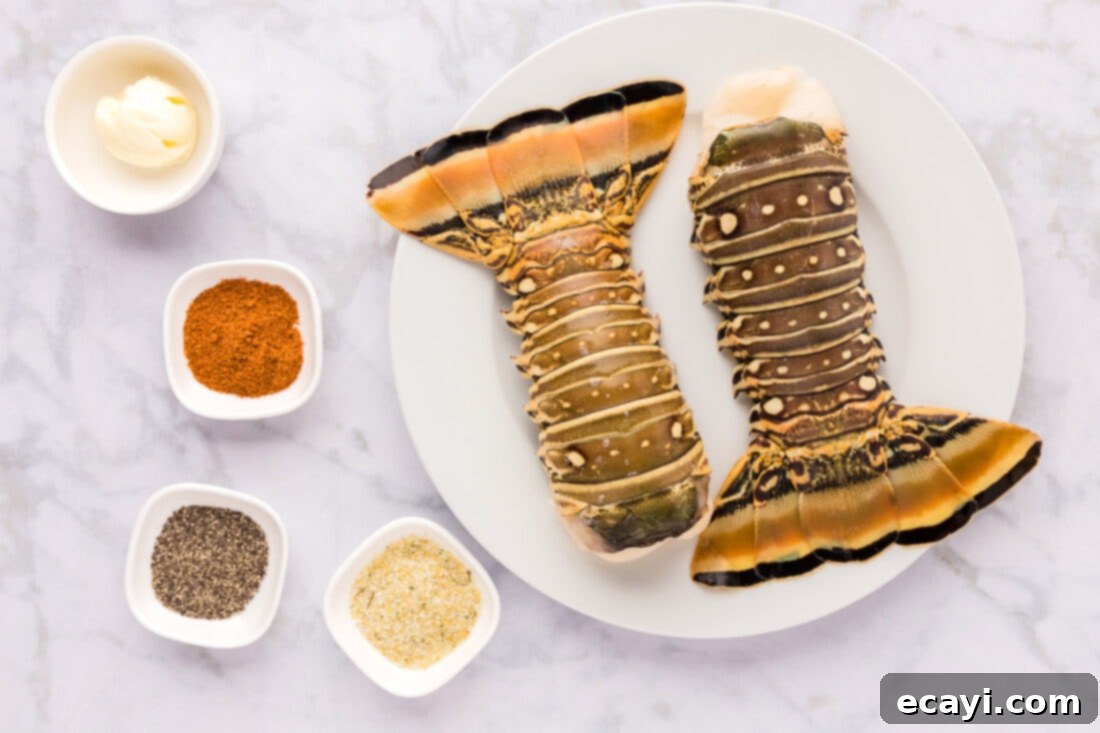
Ingredient Spotlight & Expert Tips for Selection
LOBSTER TAILS: The star of our dish! Most lobster tails sold in stores are frozen, which is perfectly fine. For the best results, always opt for cold-water lobster tails, such as those from Maine or Canada. They tend to have firmer, sweeter meat compared to warm-water varieties. When purchasing frozen tails, look for ones that are solid white, with no discoloration or black spots, which can indicate poor handling or freezer burn. Make sure to thaw your lobster tails thoroughly overnight in the refrigerator. Proper thawing is crucial for even cooking and for the seasonings to adhere beautifully. If you’re in a hurry, you can submerge them in a bowl of cold water (still in their packaging) for 30-45 minutes, changing the water every 15 minutes, but never use hot or warm water as it can start to cook the delicate meat.
BUTTER: Butter is essential for both flavor and moisture. It acts as a basting agent, keeping the lobster meat tender and preventing it from drying out on the hot grill. Using a good quality unsalted butter allows you to control the overall saltiness of the dish, especially since Old Bay seasoning already contains salt. It’s vital to allow your butter to soften completely at room temperature for about an hour before you begin. This makes it easily brushable and ensures even coating. If you forget to take it out in advance, you can gently soften it in the microwave on a very low power setting for short bursts, being careful not to melt it completely.
BLACK PEPPER: Freshly ground black pepper adds a subtle kick and aromatic depth that complements the richness of the lobster. While pre-ground pepper works, fresh pepper provides a more potent flavor and fragrance. Adjust the amount to your personal preference; a little goes a long way to enhance the overall spice profile.
GARLIC SALT: This seasoning is a powerhouse for adding savory depth. It combines the pungent flavor of garlic with the essential salinity needed for seasoning. It’s a convenient way to get both flavors in one go, ensuring an even distribution. If you only have garlic powder and regular salt, you can substitute, using approximately ½ teaspoon of garlic powder and ¼ teaspoon of salt per teaspoon of garlic salt, adjusting to taste.
OLD BAY SEASONING: A classic for seafood, Old Bay seasoning is non-negotiable for achieving that authentic, savory, and slightly spicy flavor profile. It’s a blend of herbs and spices, including celery salt, paprika, and red pepper, that perfectly complements lobster. If you don’t have Old Bay, a homemade blend of paprika, cayenne pepper, dry mustard, celery salt, black pepper, and bay leaf powder can be a suitable, though not identical, substitute. This spice blend really elevates the dish, giving it a distinctive coastal flavor.
Step-by-Step Guide: How to Make Grilled Lobster Tail
These step-by-step photos and detailed instructions are here to help you visualize how to master this recipe. For a convenient printable version, complete with precise measurements and instructions, simply jump to the recipe card at the bottom of this page.
- Prepare the Grill: Begin by brushing your grill grates with a small amount of vegetable oil or spraying them with cooking spray. This crucial step prevents the delicate lobster meat from sticking. Preheat your grill to high heat. A properly preheated, hot grill is essential for a beautiful sear on the lobster, locking in juices and flavor. You’ll reduce the heat later, but starting hot is key for that initial golden crust.
EXPERT TIP: Don’t rush the preheating. A screaming hot grill ensures a quick, perfect sear. The high heat creates the desirable maillard reaction, caramelizing the natural sugars in the lobster meat and producing a rich, flavorful crust. Once seared, the heat will be reduced to gently cook the lobster through without overdoing it.
- Butterfly the Lobster Tails: Using a sharp pair of kitchen shears, carefully cut down the center of the hard top shell of each lobster tail, stopping just before you cut through the tail fin. This lengthwise cut should expose the meat. Next, turn the lobster tail over and gently press along the underside with your thumbs. This action helps to crack the softer underbelly shell, allowing you to easily open and butterfly the tail. Take your time to avoid tearing the meat.


- Expose the Meat: After butterflying, gently turn the lobster tail back over. Carefully spread the shell open with your hands, lifting the lobster meat out of the shell and resting it on top of the shell. This creates a beautiful presentation and allows for even seasoning and grilling. Ensure the meat is fully exposed and sitting proudly on the shell, resembling a butterfly. This technique ensures maximum surface area for seasoning and direct heat.


- Season the Lobster: Generously season the exposed lobster meat with black pepper, garlic salt, and Old Bay seasoning. Don’t be shy, but remember that Old Bay and garlic salt already contain sodium. You may find you have a small amount of seasoning mixture left over, which can be saved for future seafood dishes. Ensure an even coat over all the meat for balanced flavor in every bite.

- Butter Brush: Take your well-softened butter and generously brush it over the seasoned lobster meat. The butter not only adds richness and flavor but also helps create that beautiful golden crust and keeps the meat incredibly moist during grilling. Ensure every part of the exposed meat is coated for optimal taste and texture.

- Initial Grill Sear: Carefully place the butterflied lobster tails on the preheated grill, meat side down. Because the grill is on high heat, flare-ups may occur from the melting butter. Keep a spray bottle filled with water handy to mist down any flames if they become too intense. Sear the meat for a quick 30-45 seconds – just enough time to develop a fantastic crust. Immediately after this initial sear, reduce the grill heat to medium.

- Continue Grilling: With the grill now set to medium heat, use tongs to occasionally move the tails around slightly to ensure they don’t stick to the grates and to promote even cooking. Continue grilling for 8-10 minutes on the meat side. After this time, carefully flip the lobster tails over, so the meat side is now facing up, nestled in the shell. This allows the shell to protect the delicate meat and steam slightly.

- Finish Cooking & Rest: Cook for an additional 5 minutes with the meat side up (total cooking time will be approximately 15 minutes, depending on tail size and grill temperature). It’s helpful to turn them over occasionally during this final stage to ensure even cooking. The lobster meat should be opaque and firm. Once cooked, remove the lobster tails from the grill, wrap them loosely in aluminum foil, and allow them to rest for 5 minutes. This resting period is crucial as it allows the juices to redistribute, resulting in incredibly tender and flavorful lobster.


Frequently Asked Questions & Expert Tips for Grilling Lobster
Absolutely! In fact, most lobster tails available commercially are sold frozen, making them a convenient option for home cooks. The key to success is ensuring they are completely thawed before you begin the preparation and grilling process. Thawing allows the seasonings to properly adhere to the meat and promotes even cooking, preventing some parts from being overcooked while others are still raw. The best method for thawing is to transfer them from the freezer to the refrigerator overnight. For a quicker thaw, submerge the sealed lobster tails in a bowl of cold water for 30-45 minutes, changing the water every 15 minutes. It’s crucial to never thaw lobster in hot or warm water, as this can negatively affect the texture and quality of the delicate meat.
For perfectly cooked, tender, and juicy lobster, the internal temperature should reach 140°F (60°C). Use an instant-read thermometer inserted into the thickest portion of the meat to get an accurate reading. It’s important to remember that lobster tails, like other proteins, will continue to cook slightly (known as carryover cooking) after they are removed from the grill and during their resting period. Aiming for 140°F ensures they reach optimal doneness without becoming tough or rubbery, which often happens with overcooked lobster.
Grilled lobster tails are undeniably best when enjoyed fresh, right off the grill. The texture and flavor are at their peak then. However, if you happen to have any leftovers, they can be safely stored. Allow the lobster to cool completely to room temperature, then place it in an airtight container. Refrigerate promptly, and consume within 1 day for the best quality and food safety. Beyond 24 hours, the texture can start to deteriorate, becoming tougher, and the flavor can diminish.
Reheating lobster can be tricky, as its delicate meat can easily become dry and rubbery. To retain moisture and flavor, place a small pat of butter on top of the cooked lobster meat. Tightly wrap the lobster tails in aluminum foil to create a steam packet. Bake them in a preheated oven set to 350°F (175°C) for approximately 7-10 minutes, or until they are warmed through. The butter and foil-wrapping method help to gently reheat the lobster, locking in moisture and preventing it from drying out, ensuring a more pleasant texture.
Both gas grills and charcoal grills work wonderfully for lobster tails. A gas grill offers precise temperature control and quick heating, making it convenient. A charcoal grill, on the other hand, imparts a distinctive smoky flavor that many find irresistible. The key, regardless of the grill type, is to ensure the grates are clean and well-oiled to prevent sticking, and that you can manage the heat effectively for searing and then gentler cooking.
While this recipe focuses on classic flavors, lobster is versatile! You can absolutely experiment with other seasonings or a light marinade. A squeeze of fresh lemon juice, a dash of smoked paprika, a pinch of cayenne for extra heat, or even a very simple herb butter (with fresh parsley or chives) can elevate the flavor. Just be mindful not to overpower the natural sweetness of the lobster. If using a marinade, ensure it’s not too acidic, which can “cook” the delicate meat (like in ceviche) before it even hits the grill.
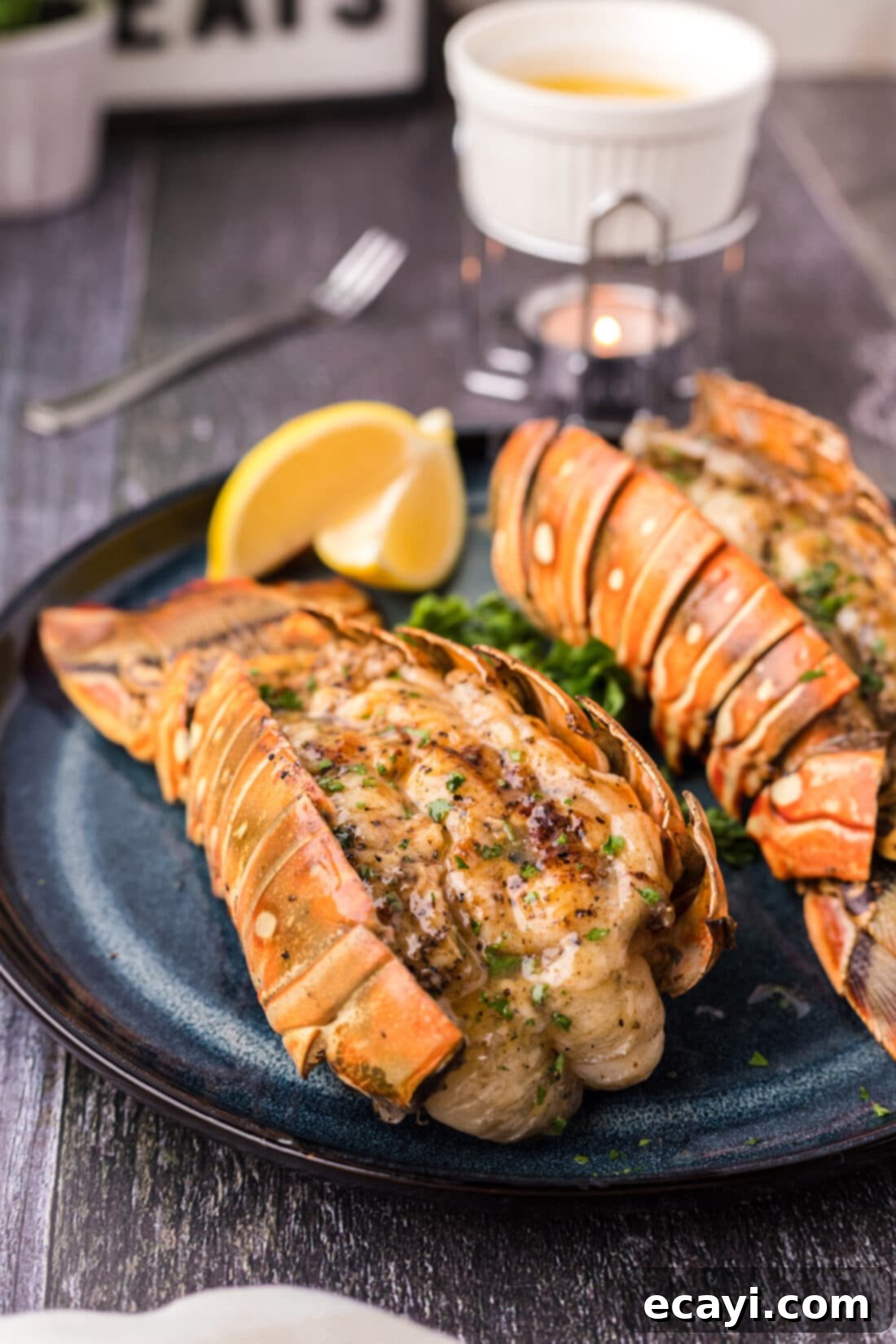
Elevate Your Meal: Delicious Serving Suggestions
Grilled lobster tails are a showstopper on their own, but pairing them with complementary side dishes can turn a delicious meal into an unforgettable dining experience. Here are some exquisite serving suggestions to accompany your perfectly grilled lobster:
- Zesty Grains: A light and flavorful lemon couscous or a wild rice pilaf makes an excellent base, offering a pleasant texture contrast to the tender lobster.
- Grilled Vegetables: Embrace the flavors of the grill by serving your lobster with complementary grilled vegetables. Grilled asparagus, sweet grilled corn on the cob, or an assortment of mixed grilled vegetables (like bell peppers, zucchini, and cherry tomatoes) add freshness and a touch of char.
- Hearty Potatoes: For a more substantial meal, consider cheesy bacon chive twice-baked potatoes or simple roasted baby potatoes with herbs. A classic baked potato with all the fixings is always a hit.
- Fresh Salads: A crisp green salad with a light vinaigrette or a vibrant coleslaw can provide a refreshing counterpoint to the richness of the lobster.
- Dipping Sauces: No lobster meal is complete without dipping sauces! Offer lemon wedges for a bright, acidic burst, and a small bowl of melted garlic butter. You can also create an Old Bay seasoned melted butter for an extra layer of flavor that echoes the seasoning on the lobster itself.
- Crusty Bread: A warm, crusty baguette or garlic bread is perfect for soaking up any leftover butter and juices.
No matter what you choose, aiming for a balance of flavors and textures will make your grilled lobster tail dinner truly special.
Discover More Delicious Lobster Recipes
If you’ve fallen in love with cooking lobster and are eager to explore more ways to enjoy this magnificent seafood, here are some other fantastic lobster recipes you might enjoy. Each offers a unique flavor profile and cooking method, showcasing the versatility of lobster:
- Lobster Risotto: A creamy, indulgent rice dish infused with rich lobster flavor, perfect for a luxurious meal.
- Lobster Thermidor: A classic French dish featuring cooked lobster meat removed from the shell, prepared with a rich brandy cream sauce, then returned to the shell and browned.
- Steamed Lobster Tail: A simple yet elegant method that highlights the natural sweetness and tender texture of lobster.
- Lobster Mac and Cheese: The ultimate comfort food elevated with succulent chunks of lobster and rich, cheesy pasta.
- Baked Lobster Tail: A straightforward and delicious way to cook lobster tails in the oven, often brushed with garlic butter.
I love to bake and cook and share my kitchen experience with all of you! Remembering to come back each day can be tough, that’s why I offer a convenient newsletter every time a new recipe posts. Simply subscribe and start receiving your free daily recipes!
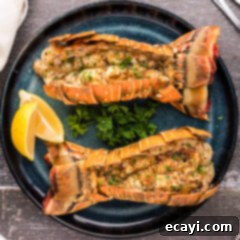
Grilled Lobster Tail
IMPORTANT – There are often Frequently Asked Questions within the blog post that you may find helpful. Simply scroll back up to read them!
Print It
Pin It
Rate It
Save ItSaved!
Ingredients
- 1 ¼ pound lobster tails thawed, if frozen
- ½ teaspoon black pepper
- 1 teaspoon garlic salt
- 1 teaspoon Old Bay seasoning
- 1 Tablespoon butter well softened
Things You’ll Need
-
Grill
-
Tongs
-
Vinyl gloves
-
Pastry brush
Before You Begin
- It’s crucial for the grill to be fully preheated and exceptionally hot before you place the lobster on it. This initial high heat creates a perfect sear and locks in the juices. Remember to reduce the heat significantly after the searing stage to prevent overcooking.
- Ensure your butter is well-softened at room temperature. This allows for easy and even brushing onto the lobster meat, which is essential for flavor and moisture. If time is short, soften it gently in the microwave on a very low power setting for short intervals.
- To guarantee perfectly cooked lobster that is tender and not rubbery, aim for an internal temperature of 140°F (60°C). Always use an instant-read thermometer inserted into the thickest part of the meat to check for doneness. Keep in mind that the lobster will continue to cook slightly (carryover cooking) during its resting period after being removed from the grill.
- Grilled lobster tails are best enjoyed immediately for optimal flavor and texture. However, if you find yourself with leftovers, store them in an airtight container in the refrigerator for up to 1 day.
- To reheat leftover lobster without drying it out, place a small pat of butter on top of the meat. Wrap the tails tightly in aluminum foil and bake in a preheated oven at 350°F (175°C) for about 7-10 minutes, or until thoroughly warmed through. The butter and foil help retain moisture during reheating.
Instructions
-
Brush grill grates with a small amount of vegetable oil or spray with cooking spray to prevent sticking. Preheat your grill to high heat.
-
Using sharp kitchen shears, cut down the center of the lobster shell, extending all the way to the tail fin but not cutting through it. Turn the lobster over and press along the underside with your thumbs to crack the underbelly shell.
-
Turn the lobster tail over again, then gently spread the shell open and lift the meat out to rest on top of the shell, fully exposing it.
-
Season the exposed lobster meat generously with black pepper, garlic salt, and Old Bay seasoning. You may have a small amount of seasoning left over.
-
Brush the seasoned lobster meat liberally with the well-softened butter.
-
Place the lobster tails on the preheated grill, meat side down. Be prepared for potential flare-ups due to the high heat and butter; a spray bottle with water can help manage them. After searing for about 30-45 seconds (enough to create a crust), reduce the grill heat to medium.
-
Continue cooking on medium heat for 8-10 minutes, using tongs to occasionally move the tails to prevent sticking. Then, turn them over so the meat side is facing up.
-
Cook for an additional 5 minutes (for a total grilling time of approximately 15 minutes), turning them over occasionally for even cooking. The lobster meat should be opaque and firm.
-
Remove the grilled lobster tails from the grill, wrap them loosely in aluminum foil, and let them rest for 5 minutes before serving. This allows the juices to redistribute for maximum tenderness.
Nutrition
The recipes on this blog are tested with a conventional gas oven and gas stovetop. It’s important to note that some ovens, especially as they age, can cook and bake inconsistently. Using an inexpensive oven thermometer can assure you that your oven is truly heating to the proper temperature. If you use a toaster oven or countertop oven, please keep in mind that they may not distribute heat the same as a conventional full sized oven and you may need to adjust your cooking/baking times. In the case of recipes made with a pressure cooker, air fryer, slow cooker, or other appliance, a link to the appliances we use is listed within each respective recipe. For baking recipes where measurements are given by weight, please note that results may not be the same if cups are used instead, and we can’t guarantee success with that method.
